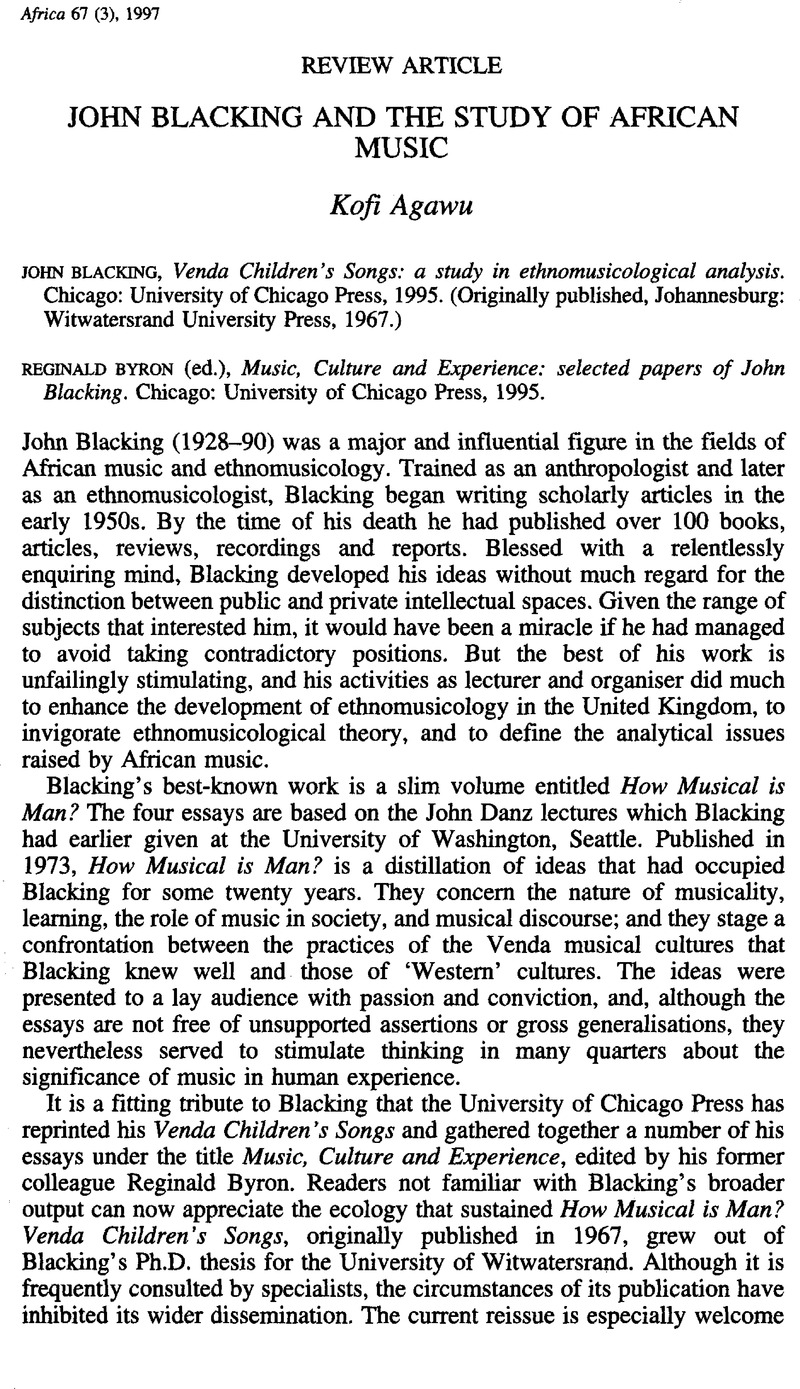No CrossRef data available.
Article contents
John Blacking and the study of African music
Published online by Cambridge University Press: 07 December 2011
Abstract
An abstract is not available for this content so a preview has been provided. Please use the Get access link above for information on how to access this content.

- Type
- Review Article
- Information
- Copyright
- Copyright © International African Institute 1997
References
REFERENCES
Adorno, Theodor W. 1967. Prisms, trans. Samuel, and Weber, Shierry. Cambridge, Mass.: MIT Press.Google Scholar
Agawu, K. 1989. ‘Schenkerian notation in concept and practice’, Music Analysis 8 (3), 275–301.CrossRefGoogle Scholar
Agawu, K. 1990. ‘Variation procedures in northern Ewe song’, Ethnomusicology 34 (2), 221–43.CrossRefGoogle Scholar
Arom, Simha. 1991. African Polyphony and Polyrhythm: musical structure and methodology. Cambridge: Cambridge University Press.CrossRefGoogle Scholar
Baily, John. 1990. ‘John Blacking and his place in ethnomusicology’, Yearbook for Traditional Music 22, xii–xxi.CrossRefGoogle Scholar
Blacking, John. 1973. How Musical is Man? Seattle and London: University of Washington Press.Google Scholar
Blacking, John. 1985. ‘The problem of “ethnic” perceptions in the semiotics of music’, in Steiner, Wendy (ed.), The Sign in Music and Literature, pp. 184–94. Austin: University of Texas Press.Google Scholar
Dahlhaus, Carl. 1983. Foundations of Music History, trans. Robinson, J. B.. New York: Cambridge University Press.CrossRefGoogle Scholar
Ekwueme, Lazarus. 1975–76. ‘Structural levels of rhythm and form in African music with particular reference to the west coast’, African Music 5 (4), 27–35.CrossRefGoogle Scholar
Ekwueme, Lazarus. 1980. ‘Analysis and analytic techniques in African music: a theory of melodic scales’, African Music 6 (1), 89–106.CrossRefGoogle Scholar
Feld, Steven. 1984. ‘Sound structure as social structure’, Ethnomusicology 28 (3), 383–409.CrossRefGoogle Scholar
Jones, A. M. 1959. Studies in African Music (2 vols.). London: Oxford University Press.Google Scholar
Keller, Hans. 1957. ‘Functional analysis: its pure application’, Music Review 18, 202–15.Google Scholar
Kyagambiddwa, Joseph. 1955. African Music from the Source of the Nile. New York: Praeger.Google Scholar
Latham, Edward, n.d. ‘Structure in Selected Folk Melodies of Africa: a Schenkerian perspective’. Unpublished seminar paper, New Haven, Conn.: Yale University.Google Scholar
Leppert, Richard and McClary, S. (eds.). 1987. Music and Society. Cambridge: Cambridge University Press.Google Scholar
Merriam, A. P. 1964. The Anthropology of Music. Evanston, Ill.: Northwestern University Press.Google Scholar
Nketia, J. H. Kwabena. 1981. ‘The juncture of the social and the musical: die methodology of cultural analysis’, The World of Music 23 (1), 22–35.Google Scholar
Stock, Jonathan. 1993. ‘The application of Schenkerian analysis to ethnomusicology: problems and possibilities’, Music Analysis 12 (2), 215–40.CrossRefGoogle Scholar
Wachsmann, Klaus P. (ed.). 1971. Music and History in Africa. Evanston, Ill.: Northwestern University Press.Google Scholar




